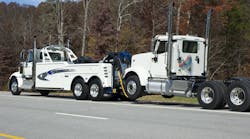The good and bad of diesel particulate filter regenerations
Passive, active and manual regenerations play a significant role in helping address trapped soot and lubrication oil ash caught in a vehicle’s diesel particulate filter (DPF), but more is often required to help avoid unplanned breakdowns, lost productivity and costly repairs, plus get the most from vehicles when they are on the road. Taking proactive measures toward DPF maintenance is vital.
“The DPF will continue to trap soot and lubrication oil ash until it is passively, actively or manually regenerated,” say Brian Lewallen, director service operations, and Dale Allemang, director field service, Daimler Trucks North America, a manufacturer of medium and heavy duty vehicles (www.daimler-trucksnorthamerica.com). “But it is like any filter on the engine and, just like an oil, fuel or air filter, it must be replaced or, in the case of the DPF, cleaned. The cleaning process is critical to the life of the DPF and of the selective catalytic reduction (SCR) catalyst located downstream.”
MAINTENANCE MEANS EVERYTHING
A DPF collects diesel particulates in a diesel engine’s exhaust through a complex filtering process, and regular, proper maintenance is necessary to ensure it continues to prevent the particulates from entering the atmosphere. If and when soot and ash builds up in a DPF, it restricts system flow and creates significant back pressure. A number of unwanted problems can result from neglecting DPF maintenance, including:
- Plugged DPF.
- Low vehicle power.
- Engine derate.
- Cracked DPF.
- Melted filters.
- Engine damage.
DPF BUILDUP AND REGENERATION CYCLES
“Each time one of the regenerations occurs and clears out the accumulated soot, the DPF can once again ‘breath,’ but a small amount of material is left behind that does not burn off, ” says Drew Taylor, owner/vice president of global sales, FSX Equipment, a provider of filter cleaning systems and services for cleaning DPFs and industrial filter cartridges (www.fsxinc.com).
According to Taylor, soot builds up due to diesel fuel. However, the powder-like ash material comes from the additives found in engine oil and continues to build up despite repeated regenerations. After a little more than 33,000 miles, nearly half the material trapped in a DPF is ash, he says. At the U.S. Environmental Protection Agency’s mandated service interval of 150,000 miles, ash makes up approximately 80 percent of the accumulated material in a DPF (compared to 20 percent for soot).
“If only 20 percent of the material can burn off by way of the onboard active regeneration system, then what about the 80 percent that cannot burn off?” asks Taylor. “The DPF must be removed from the exhaust line and mechanically cleaned to remove the remaining 80 percent ash content.”
When the soot-ash ratio reaches such a level, back pressure becomes more of an issue and regenerations are repeated. After time, those regenerations only serve to transform the ash into a “hardened, immovable block that destroys the DPF,” he says.
Paying attention to the frequency of a vehicle’s regeneration cycles is the most effective way to determine whether or not there has been significant ash buildup in its DPF. If they are ignored, the end result could be an irreversibly-damaged DPF that is cracked, glazed or melted.
“Sensors detect high-pressure differential caused by ash deposits in the DPF and an active regeneration is initiated,” says Taylor. “However, trying to burn ash is like trying to burn rock. It’s not going to happen.”
According to Daimler’s Lewallen and Allemang, the primary reason for an unsuccessful DPF regeneration is failure to attain the desired exhaust gas temperature in the diesel oxidation catalyst (DOC) and DPF to burn the collected soot.
“An obstructed fuel injection doser line may be preventing fuel injection from occurring to elevate temperatures into the DOC and DPF,” they say. “The DOC can become face plugged after extended periods of low load and low speed engine operation, thereby restricting flow through the DOC and DPF, as well as limiting the exhaust temperature.”
DPF-RELATED WARNINGS
Illumination of the DPF status lamp indicates the vehicle’s desire for a regeneration. More specifically, says FSX Equipment’s Taylor, a solid light indicates a partial DPF regeneration is required, and a flashing light indicates a full DPF regeneration is necessary. When a vehicle’s DPF is full and engine performance is limited, the driver will be informed via a flashing or solid general warning lamp or alarm. If a driver encounters a stop alert or solid alarm, the DPF is over full and the engine will shut down soon.
“The driver should pull over immediately, stop the engine and seek service,” says Taylor. “Do not attempt a parked regeneration.”
THE CLEANER THE DPF, THE BETTER
Ash buildup in the DPF also affects the accuracy of the information gleaned from its status indicator lamp on the vehicle. Taylor of FSX Equipment advises those found on Class 8 long haul trucks should be removed and cleaned to nearly-new condition at 100,000 miles to avoid continued forced regenerations and the potentially serious damage to the DPF that could come along with them (See sidebar on dealing with ash buildup in a DPF).
“If you make DPF ash cleaning a standard procedure in all of your annual preventive maintenance schedules, you will eliminate 99 percent of your DPF problems,” says Taylor.
The quality of the DPF cleaning process will also determine how long it will be before a vehicle begins to show symptoms of ash and soot buildup.
“The worst thing to do is reinstall a DPF thought to be clean, only to find out after several hours of vehicle troubleshooting that it wasn’t and a lot of ash was left behind,” Taylor says. “Good cleaners have a lot of power and a visible process for knowing when the cleaning is finished. And those good cleaners are run by conscientious technicians that take pride in their work and take the time to do the job right.”




